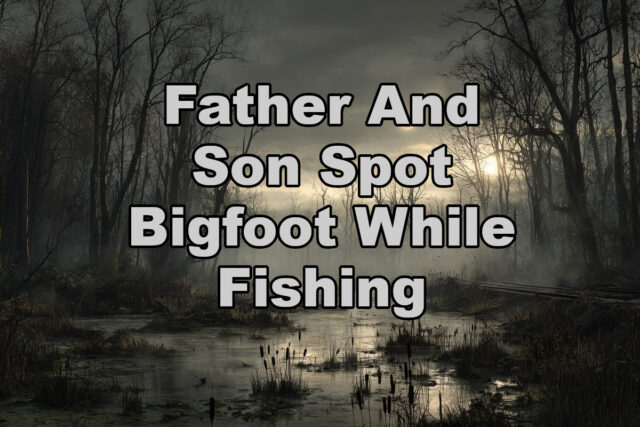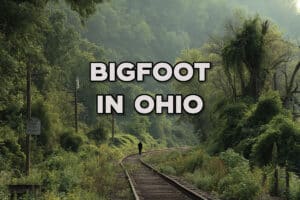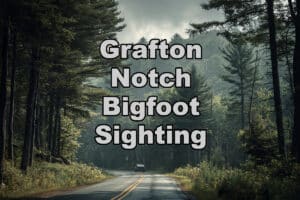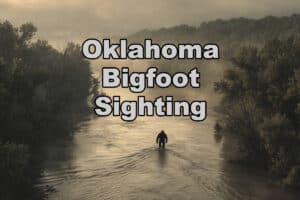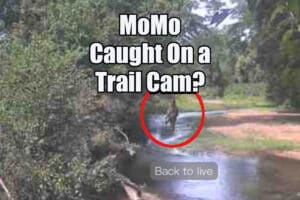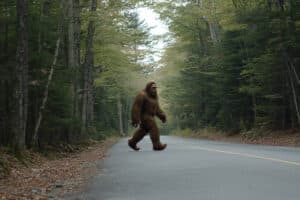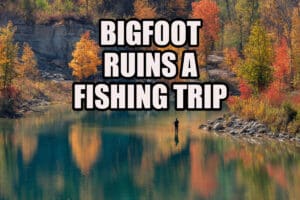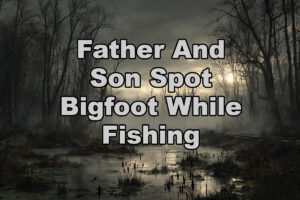
Edward Henry and his 12-year-old son were enjoying a peaceful bow fishing expedition near Monroe, Michigan on May 18, 2025, when their outdoor adventure took an extraordinary turn. What started as a routine trip to the marshlands along Plum Creek became a heart-pounding encounter with what they describe as a massive, gorilla-like creature that defied explanation. “Holy shit what was that?? It was as big as a bear but it looked like a gorilla!” the young witness exclaimed moments after the creature vanished into the forest.
An Experienced Outdoorsman’s Morning Routine
Edward Henry, a 47-year-old demolition worker born and raised in the Monroe area, knows these local waterways like the back of his hand. His decades of experience in the Michigan outdoors make his account particularly compelling to investigators. “I’ve been fishing and hunting these areas my whole life,” Henry explained to BFRO investigator Matthew Moneymaker. “I know what belongs here and what doesn’t.”
On that bright spring morning around 11:30 AM, Henry and his son had walked down Plum Creek past four railroad bridges, heading into the familiar marsh behind the Monroe County Jail near an old quarry. The weather conditions were ideal for bow fishing—clear skies with good visibility through the wetlands. Both father and son were alert and sober, focused on their fishing expedition when the unexpected encounter unfolded.
“We walked down the creek past four bridges and headed into the marsh,” Henry recounted. “About 100 yards into the marsh, the dog scared up something that was bedded there. Trees were shaking. We thought it was a group of deer at first.”
The Encounter Unfolds
The family continued deeper into the marsh, eventually reaching the creek basin where they settled in to observe the abundant wildlife. The area is known for its thriving deer population, protected from hunting due to its proximity to residential areas. After enjoying the peaceful surroundings for a while, the trio began their journey back through the cattails, noting numerous deer beds along their route.
“We crossed the first bridge and was between that and the second bridge,” Henry detailed. “We heard sirens in the distance. My son said ‘do you hear those?’ I sat down my bow and arrow to get out my cell phone and earbuds. I wanted to listen to the police scanner app on my phone to see what was happening.”
It was at this moment of distraction that their world changed forever. “My son was behind me and dog was off to the right. All of a sudden I heard rustling in a tree to the left and a huge thud hitting the ground from the tree,” Henry described, his voice still carrying the shock of the memory.
“A big heavy animal hit the ground and crouched and start moving towards me through brush,” he continued. “My dog fired off from the right of me toward the creature. The dog almost got to it but the creature shot off extremely fast through trees and brush.”
The family’s dog, apparently sensing the unusual nature of the intruder, immediately gave chase. “The dog chased the creature up the slope and over the train tracks,” Henry reported. “I then called for my dog to come back.”
A Creature Unlike Any Known Animal
When pressed for specific details about the creature’s appearance, both witnesses provided remarkably consistent descriptions. The entity had been approximately 10 feet up in a tree when it jumped down, landing with considerable force that suggested significant weight and mass.
“At no time was it facing the two humans,” BFRO investigator Matthew Moneymaker noted after conducting separate interviews with both witnesses. “The point at which they got the clearest look at it was when it was ascending the embankment. They could see the hairy back and big butt cheeks pretty clearly for a few seconds.”
Young Henry’s description was particularly vivid: “It was as big as a bear but it looked like a gorilla!” The boy’s comparison proved accurate when investigators probed deeper into the creature’s locomotion and physical characteristics.
“The animal was not on all fours,” Moneymaker confirmed. “It raced up the slope on two legs but hunched forward. In its hunched posture it was nearly six feet tall. The son said it would have been much taller if not hunched over.”
The creature’s speed and agility particularly impressed both witnesses. After the initial landing and crouch, it moved with remarkable swiftness through dense brush and vegetation that would challenge most large animals. “The creature shot off extremely fast through trees and brush,” Henry emphasized, noting that even their dog, bred for chasing game, could barely keep pace.
A Hasty Retreat
The entire encounter lasted less than ten seconds from the initial tree rustling to the creature’s disappearance over the railroad tracks. The speed and shock of the event left no opportunity for photographs or video, though both witnesses remained completely lucid throughout the experience.
“This incident happened so fast that there was no time to even consider trying to photograph it,” Moneymaker observed. “The whole encounter lasted less than ten seconds from beginning to end. It happened totally by surprise. No one would have gotten a photo of it in that first shock interval.”
The psychological impact was immediate and lasting. “We walked back but we heard something crunching on the ground behind us,” Henry reported. “We left!” The decision to evacuate the area quickly proved wise, as the witnesses continued to hear movement in the forest that suggested they were being observed or followed during their retreat.
This account is based on Edward Henry’s detailed report to the Bigfoot Field Researchers Organization, filed on May 18, 2025. BFRO investigator Matthew Moneymaker conducted follow-up interviews with both witnesses to verify the details of this encounter.
A History of Encounters in Monroe County
The Monroe County area has a documented history of unusual sightings dating back to 1963, with numerous newspaper articles chronicling unexplained encounters over the decades. The location of this recent sighting—a protected marsh area between major transportation corridors—provides an ideal habitat for elusive wildlife.
This particular stretch of wetland offers everything a large, omnivorous creature might need for survival. The abundant deer population, protected from hunting due to proximity to residential areas, provides a reliable protein source. The extensive cattail marshes offer both shelter and food, as these plants are known to be consumed by Bigfoot during winter months when other vegetation is scarce.
“This area around the marsh for Tamarack Creek is full of deer,” Moneymaker explained. “No hunting is allowed there. Only fishing is allowed there. Consequently there are herds of deer in the marsh and woods year round. There are lots of cattails around this marsh as well. Therefore, two things bigfoots consume, especially in winter: cattails and deer.”
The geographic location also provides strategic advantages for a creature seeking to avoid human contact while maintaining access to necessary resources. Railroad corridors offer natural travel routes that connect isolated pockets of wilderness with larger forest areas and agricultural lands. “Bigfoots will walk along railroad beds for long distances,” Moneymaker noted. “The railroad beds will sometime bring them into pockets of woods very close to towns, as it this case.”
Expert Analysis and Validation
BFRO investigator Matthew Moneymaker’s assessment of the encounter carries significant weight within the cryptozoological research community. As the founder of the Bigfoot Field Researchers Organization and former co-host of Animal Planet’s “Finding Bigfoot,” Moneymaker brings decades of experience in evaluating eyewitness accounts.
“I spoke with Edward and his 12 year old son by phone, separately,” Moneymaker reported. “Both are credible and freshly descriptive about what happened to them this morning. Edward is 47. He was born and raised in the area. He earns a good living working in the demolition trade.”
The investigator’s rigorous questioning focused on eliminating conventional explanations for the sighting. “I asked many questions about what they saw, and what the animal did. I asked enough to discern that it was not a bear. It was a large dark furred primate that ran up a slope on two legs looking like a gorilla from behind. Yes, that would be a bigfoot.”
The consistency between both witnesses’ independent accounts, combined with their emotional authenticity and lack of any apparent motive for fabrication, strengthened the credibility assessment. The speed and shock of the encounter also aligned with typical patterns seen in legitimate Bigfoot sightings, where witnesses have minimal time to process what they’re observing.
The Broader Implications
This sighting adds to a growing body of evidence suggesting that Sasquatch populations may be adapting to increased human development by utilizing protected green spaces near urban areas. The phenomenon of cryptid encounters in unexpected locations challenges traditional assumptions about where these creatures might be found.
“The closer a nature pocket is to a town, the greater likelihood that hunting is forbidden there (so the bullets don’t travel into the neighborhoods),” Moneymaker explained. “The area becomes a defacto safe haven for deer herds. Bigfoot look for deer so they will sometimes end up in pockets of woods near towns like Monroe when there is enough plants and animals to sustain them.”
This strategic use of protected areas near human settlements represents a form of adaptive intelligence that further supports the theory that these creatures possess cognitive abilities beyond those of typical wildlife. The ability to recognize and exploit human behavioral patterns—such as hunting restrictions near residential areas—suggests a level of environmental awareness that few animals demonstrate.
Edward Henry remains convinced of what he and his son encountered that spring morning in the Monroe County marsh. “People can believe what they want,” he concluded. “I know what I saw, and it wasn’t any animal I’ve ever seen before.” The experience has left both witnesses with a permanent reminder that Michigan’s wilderness still holds mysteries that science has yet to fully understand.

